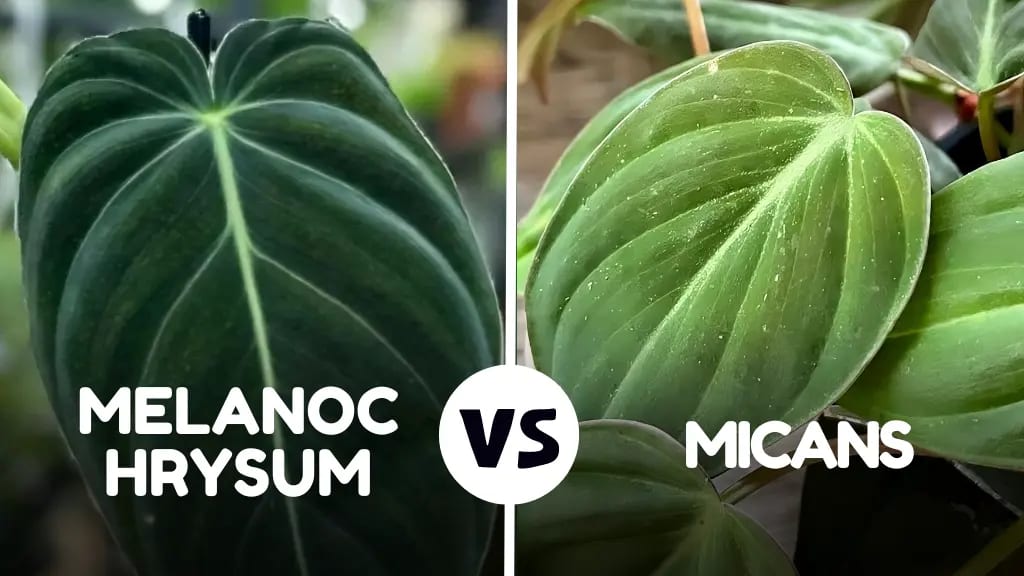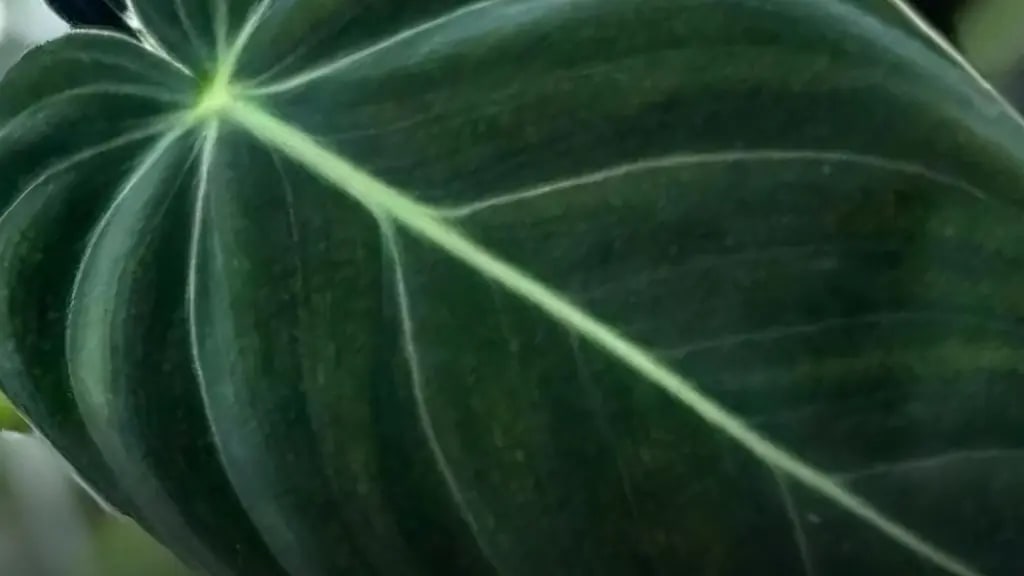Both Philodendron Melanochrysum and Micans are gorgeous plants that share some similar features. These stunning plants require low maintenance and care to grow and thrive; thus, most gardeners love keeping them indoors.
Both varieties of Philodendron boast lush, heart-shaped leaves with a captivating sheen. Although they resemble some similar features, both these Philodendrons are different from each other in several ways.

So, go through this post to find out the similarities and differences between Melanochrysum and means before getting one.
Melanochrysum Vs. Micans
Although both these plants boast velvety heart-shaped leaves, some features make them different from each other.
| Appearance | 🌱Melanochrysum | 🌱 Micans |
|---|---|---|
| 🌿 Leaf Shape and Size | Its matured leaves can reach 2 feet in length, with wider more elongated heart-shaped leaves. Its luxurious, velvety drapes make it a show-stopper. | They resemble more rounded heart-shaped leaves that typically stay within the 2 to 4-inch range. This variety is more petite and delicate. |
| 🌿 Leaf Color and Texture | New leaves mostly have an orange hue or stunning bronze color with a deeper green taking center stage. Its velvety texture is undeniable. | Its leaves boast a mix of light green with a subtle, reddish-brown undertone. It is lighter and the velvety texture is thinner than a Melanochrysum. |
| 🌿 Petiole and Stem | It has a sturdy and thicker stem that leans towards a climbing habit. The petioles are thicker and shorter with a green sheath. | It has more flexible and thinner stems that make the plant climb or trail. Petioles boast a reddish hue and are more delicate, and longer. New growths are enclosed in a sheath and emerge from the top of the petiole. |
Growing Habits
Understanding the growing habits of both these varieties of Philodendron can help you provide them with the required support and environment.

Spreading or Vining
Melanochrysum is not a true climber, it needs support as its leaves get larger. A Melanochrysum leans towards a more, upright and self-heading growth pattern.
Using a trellis or a moss pole can prevent leaning and thus, encourage proper growth. on the other hand, Micans thrive on climbing or trailing.
This plant can be easily placed on a hanging basket as its flexible thin stems wrap around supports and cascade down the shelves.
Plant size when matured
A Melanochrysum can spread up to 2 to 3 feet with proper support and become 3 to 4 feet tall.
A mature micans can reach a spread and height of around 2 feet. This plant is mostly smaller in stature and shows a delightful bushy charm when grown freely.
Growth Rate
A Melanochrysum is a slow grower. It puts new leaves at a pace of 6 to 12 inches yearly. However, Micans offers faster growth and new leaves appear every few months.
How to Care

Proper care can make these plants grow, fast, thrive well and stay healthy.
Light Needed
Unlike most varieties of Philodendrons, a melanochrysum prefers indirect bright light. Placing them near an east-facing window can be the best option. Always avoid direct scorching sunlight as it can damage the velvety leaves.
Although Micans prefer bright, indirect light, they can even survive in lower light conditions. North-facing windows can be ideal for this plant.
Watering
Water Mealnochrysum when the top 2 inches of the soil dries out. This plant prefers to dry out slightly between watering.
On the other hand, Micans prefer a moderate watering schedule. Water the plant after checking the moisture level of the soil. If you want more information on soil mix read this: Philodendron Watering Guide: Methods for Healthy Foliage
Humidity
Melanochrysum prefers a higher humidity level ideally around 60 % and not less than that. Using a humidifier or a pebble tray can increase the humidity level around the plant.
Although Micans prefer higher humidity levels, they can even tolerate average household humidity levels. Misting from time to time can be beneficial for the plant.
Fertilizer and Soil
Both Micans and Melanochrysum prefer well-draining, aerated soil. Using a mixture of orchid bark, potting soil, and perlite can be a good option.
Feeding should be done using a balanced, diluted fertilizer during summer and spring as it is the growing season of the Philodendrons. Avoid fertilizing during fall and winter.
Similarities Between a Melanochrysum and a Micans
This table shows a few shared traits between both the varieties of Philodendron.
| Factors | Melanochrysum | Micans |
| Easy Care | Easy to Take Care of. | Needs a Little Care. |
| Purifying Air | Purifies Air. | Makes Air Toxin-free and Purifies. |
| Velvety Leaves | Have Gorgeous Velvety Leaves. | Its Velvety Leaves Are Stunning. |
| Heart-shaped Leaves | Leaves Are of Heart Shape. | Have Heart-shaped Leaves. |
Differences Between a Micans and a Melanochrysum
Here are some factors that make these Philodendrons different from each other.
| Factors | Melanochrysum | Micans |
| Size of the Leaves | Leaf size can be 2 feet long when matured. | Leaf size becomes 2 to 4 inches on reaching maturity. |
| Color of the Leaves | Its leaves are rich deep green with orange/bronze hues. | Leaves are lighter green with a reddish-brown undertone. |
| Growth Habit | Self-heading, upright. | Trail or climb. |
| Plant Size When Matured | Can spread up to 2 to 3 feet and become 3 to 4 feet tall when mature. | 2 feet spread and tall. |
| Growth Rate | Moderate growth of 6 to 12 inches every year. | Faster growth with new leaves every few months. |
| Amount of Light | Prefers bright indirect light. | Prefers bright, indirect light. Can tolerate low light conditions. |
| Humidity Level | The ideal humidity level should be 60% or more. | Tolerant to average household humidity. |
Which Philodendron Can Be Perfect for You?
Factors like light condition, space, and your personal preferences play an important role in determining which variety of Philodendron is right for you. Here, are some tips to help you get the right plant.
Space Available
If you have a bigger house with ample floor space then, growing a Melanochrysum can be a good idea. This variety of Philodendron reaches a majestic size when matured.
On the other hand, Micans can thrive even in smaller spaces. You can easily train this versatile plant to cascade from a hanging basket or climb a moss pole.
Lighting Conditions
A Melanochrysum can only survive in places with sufficient indirect bright light. It will bask in the dappled sunlight. So, while growing this variety you need to make sure your home boasts plenty of east-facing windows.
However, Micans can tolerate low light levels and thus, are more adaptable. It can thrive well in rooms with artificial light and north-facing windows.
Your Personal Preference
If you want to create a luxurious jungle-like vibe, then planting a Melanochrysum with its upright growth habit and velvety leaves can be an ideal option for you.
However, growing Micans can offer their charming and delicate presence. This plant with its vining nature and smaller heart-shaped leaves will make your day.
Final Touch Up
Although Melanochrysum and Micans resemble a few similar features, they offer some distinct personalities. Both these varieties of Philodendron are stunning additions to any plant collection.
Choosing the right Philodendron boils down to your personal preferences, and growing environment and also brings a touch of tropics to your home.